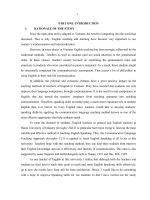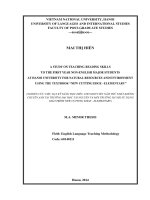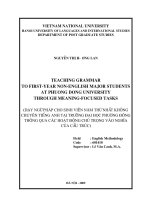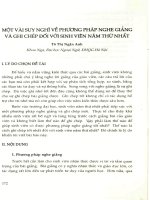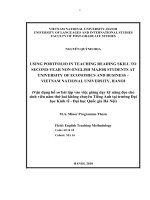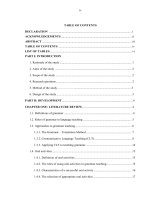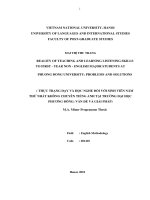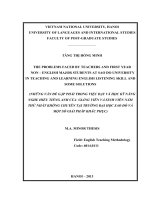Thực trạng dạy và học nghe đối với sinh viên năm thứ nhất không chuyên tiếng Anh tại trường Đại học Phương Đông vấn đề và giải pháp
Bạn đang xem bản rút gọn của tài liệu. Xem và tải ngay bản đầy đủ của tài liệu tại đây (562.36 KB, 71 trang )
i
VIETNAM NATIONAL UNIVERSITY, HANOI
UNIVERSITY OF LANGUAGES AND INTERNATIONAL STUDIES
FACULTY OF POST-GRADUATE STUDIES
MAI THỊ THU TRANG
REALITY OF TEACHING AND LEARNING LISTENING SKILLS
TO FIRST - YEAR NON - ENGLISH MAJOR STUDENTS AT
PHUONG DONG UNIVERSITY: PROBLEMS AND SOLUTIONS
( THỰC TRẠNG DẠY VÀ HỌC NGHE ĐỐI VỚI SINH VIÊN NĂM
THỨ NHẤT KHÔNG CHUYÊN TIẾNG ANH TẠI TRƯỜNG ĐẠI HỌC
PHƯƠNG ĐÔNG: VẤN ĐỀ VÀ GIẢI PHÁP)
M.A. Minor Programme Thesis
Field
: English Methodology
Code
: 601410
Hanoi, 2010
ii
VIETNAM NATIONAL UNIVERSITY, HANOI
UNIVERSITY OF LANGUAGES AND INTERNATIONAL STUDIES
FACULTY OF POST-GRADUATE STUDIES
MAI THỊ THU TRANG
REALITY OF TEACHING AND LEARNING LISTENING SKILLS
TO FIRST - YEAR NON - ENGLISH MAJOR STUDENTS AT PHUONG
DONG UNIVERSITY: PROBLEMS AND SOLUTIONS
( THỰC TRẠNG DẠY VÀ HỌC NGHE ĐỐI VỚI SINH VIÊN NĂM
THỨ NHẤT KHÔNG CHUYÊN TIẾNG ANH TẠI TRƯỜNG ĐẠI HỌC
PHƯƠNG ĐÔNG: VẤN ĐỀ VÀ GIẢI PHÁP)
M.A. Minor Programme Thesis
Field
: English Methodology
Code
: 601410
Supervisor : NGUYễN MINH HUệ, M.A
Hanoi, 2010
vi
LIST OF CHARTS
Chart 1: Teachers‟ situational problems
Chart 2: Teachers‟ problems from listening materials
Chart 3: Teachers‟ problems from students
Chart 4: Teachers‟ solutions to the problem of background noise in teaching listening
Chart 5: Teachers‟ solutions to the problem of large class size
Chart 6: Teachers‟ solutions to the problem of multi-level class
Chart 7: Teachers‟ solutions to the problem of poor teaching equipments
Chart 8: Teachers‟ solutions to the problem of unfamiliar topics to students
Chart 9: Teachers‟ solution to the problem of texts having different accents
Chart 10: Teachers‟ solutions to the problem of fast speed of speech
Chart 11: Teachers‟ solutions when the listening text has unfamiliar sounds to students.
Chart 12: Teachers‟ solutions to the problem of students‟ low motivation
Chart 13: Teachers‟ solutions to the problem of students‟ low level of proficiency
Chart 14: Teachers‟ solutions to the problem of students‟ anxiety
Chart 15: Teachers‟ solutions to the problem of students‟ limited vocabulary and structures
Chart 16: Teachers‟ solutions to the problem if students‟ lack of background knowledge
Chart 17: Students‟ situational problems
Chart 18: Students‟ problems from listening materials
Chart 19: Students‟ problems from students themselves
Chart 20: Students‟ solutions to the problems of background noise in listening lessons
Chart 21: Students‟ solutions to the problem of listening in large class
Chart 22: Students‟ solutions to the problem of listening in multi-level class
Chart 23: Students‟ suggestions for teaching equipments in listening lesson.
Chart 24: Students‟ solutions to the problem of unfamiliar topics
Chart 25: Students‟ solution to the problem of texts having different accents
Chart 26: Students‟ solutions to the problem of unfamiliar sounds
Chart 27: Students‟ solutions to the problem of texts having fast speed of speech
Chart 28: Students‟ solutions to their low motivation in learning listening
Chart 29: Students‟ solutions to the problem of difficult texts
vii
Chart 30: Students‟ solutions to their anxiety
Chart 31: Students‟ solutions to the problem of texts having new vocabulary and structures
Chart 32: Students‟ solutions to their lack of background knowledge
viii
TABLE OF CONTENTS
Declaration…………………………………………………………………………………..
i
Acknowledgements………………………………………………………………………….
ii
Abstract……………………………………………………………………………………… iii
List of tables…………………………………………………………………………………
iv
Table of contents…………………………………………………………………………….
vi
CHAPTER ONE: INTRODUCTION…………………………………………………….. 1
1.1. Statement of problem and rationale……………………………………………. 1
1.2. Aims of the study………………………………………………………………… 2
1.3. Research questions………………………………………………………………. 2
1.4. Scope of the study………………………………………………………………..
2
1.5. Significance of the study………………………………………………………… 2
1.6. Design of the study ………………………………………………………………
3
CHAPTER TWO: LITERATURE REVIEW…………………………………………….. 4
2.1. Definition of listening…………………………………………………………… 4
2.2. Types of listening process………………………………………………………. 4
2.3. Common methods of teaching listening skill………………………………….. 5
2.4. Teaching listening in the view of task – based approach……………………..
6
2.5. Teachers and students’ problems and solutions in teaching and learning 7
listening………………………………………………………………………………………
2.5.1. Situational problems……………………………………………………
7
2.5.2. Problem from the listening materials………………………………….
8
2.5.3. Problems from student factors…………………………………………
9
CHAPTER THREE: RESEARCH METHODOLOGY………………………………….
12
3.1. The setting of the study………………………………………………………...
12
3.2. Participants……………………………………………………………………..
12
3.3. The data collection methods and procedures…………………………………
13
3.4. Data analysis……………………………………………………………………. 14
CHAPTER FOUR: DATA ANALYSIS…………………………………………………… 15
4.1. Teachers’ problems in teaching listening……………………………………..
15
4.2. Teachers’ solutions to the problems…………………………………………... 17
ix
4.3. Students’ problems in learning listening……………………………………...
24
4.4. Students’ solutions to the problems…………………………………………...
27
CHAPTER FIVE: RESULTS DISCUSSION……………………………………………..
35
5.1. Teachers’ problems in teaching listening…………………………………….
35
5.2. Teachers’ solutions to the problems………………………………………….. 36
5.3. Students’ problems in learning listening……………………………………..
37
5.4. Students’ solutions to the problems…………………………………………..
38
CHAPTER SIX: IMPLICATIONS………………………………………………………... 40
6.1. Implications for the university………………………………………………..
40
6.2. Implications for the teachers………………………………………………….
40
6.3. Implications for the students………………………………………………….
41
CHAPTER SEVEN: CONCLUSION……………………………………………………...
43
7.1. Summary of the study…………………………………………………………
43
7.2. Suggestions for further study…………………………………………………. 43
REFERENCES……………………………………………………………………………… 44
APPENDICES……………………………………………………………………………….
I
APPENDIX 1: Survey questionnaires for teachers……………………………………….
I
APPENDIX 2: Survey questionnaires for students……………………………………….
VI
APPENDIX 3: Interviews with teachers…………………………………………………... XI
APPENDIX 4: Interviews with students…………………………………………………..
XV
1
CHAPTER ONE: INTRODUCTION
1.1. Statement of problem and rationale
In the time of globalization, the ability to acquire and use English well is considered
the key to achieve success. Learning English is no longer a priority but a necessity in the
present time. It is the reason why many researchers and educators express their concern about
the methods to improve the quality of teaching and learning English.
In the context of Phuong Dong University (PDU), great concern is put on listening. Many
students have raised their worries about the weak improvement in their listening ability. The
students in Phuong Dong University, especially the first year non English major ones found it
difficult to perform listening tasks because of various reasons such as their low background
knowledge, limited vocabulary and structures, low motivation, act. Moreover, some students
stated that in their high schools, they did not have chances to access listening, therefore when
they move to university they lack experiences in acquiring this kind of skill. Others have
linked listening lessons with something much difficult and boring. For the teachers in PDU,
they revealed that sometimes they find it challenging to have a successful lessons and it is
really difficult to motivate students in learning listening skill. Although they have put great
effort to increase students‟ interest, students‟ motivation sometimes is low and the listening
lessons are stated to be boring and useless.
In addition, although in PDU, many researches were conducted in methods of English
teaching, not many of them were in listening. Most of them were to focus on speaking and
reading as well. It means that in this context, there remains a lack of research in the field of
listening.
This above situation has inspired me to conduct a research study on the reality of listening
and teaching listening to first - year non - English major students at Phuong Dong University:
Problems and Solutions.
1.2. Aims of the study
In general, the study is to investigate the current situation of teaching and learning
listening skills to the first - year non – English major students at elementary level at PDU.
2
Specifically, the study aims at:
- Identifying the problems that teachers and students encounter in listening course.
- Finding out teachers‟ and students‟ solutions to these problems.
- Providing some recommendations for the teachers and students to consult and apply in their
teaching and learning listening skills.
1.3. Research questions
1. What problems do the teachers have in a listening lesson?
2. What solutions to the problems do the teachers suggest?
3. What problems do the students have in a listening lesson?
4. What solutions to the problems do the students suggest?
1.4. Scope of the study
The study put its focus on the reality of listening and teaching listening to first – year
non - English major students at Phuong Dong University at elementary level of English
proficiency. Due to the limited time, the surveys and interviews are conducted on 100
learners of elementary level and teachers in Faculty of Biotechnology (FOB) through their
listening course with the textbook named “New Headway Elementary-Third Edition” by Liz
and John Soars, Oxford University Press. By this, the researcher aims to find out their
problems and solutions in teaching and learning listening.
1.5. Significance of the study
Listening is considered the most difficult skill to the students and “more demanding
than talking” Green (2006, p.44). As Rost (1994, p.141) states: “Listening is vital in the
language classroom because it provides input for the learners. Without understandable input
at the right level, any learning simply cannot begin”. Therefore, it is necessary for teachers of
English language to realize the importance of how to make progress and feel interested in
listening comprehension.
This study owns its significance to find out the problems encountered by teachers and
students and give suggestions for implementing techniques to motivate the first year – non
major students to improve their listening skills. Therefore, it plays an important role in
enriching the methodology of teaching listening skills. Furthermore, the results of the study
will contribute and suggest ideas for later research on the same field.
3
1.6. Design of the study
The thesis consists of seven chapters:
Chapter one is the introduction to the study which presents the statement of problem and
rationale; aims of the study; research questions; scope of the study; significance of the study
and design of the study.
Chapter two focuses on the basic theoretical background from the literature review on
listening skills.
Chapter three presents the research methodology which describes how the research was
carried out.
Chapter four is on data analysis.
Chapter five presents and discusses the finding of the surveys. In other words, it helps to find
the answers for the four research questions.
Chapter six provides some recommendations for the development of teaching and learning
listening to the first year non English majors at PDU.
Chapter seven is the conclusion which summarizes the thesis and makes some suggestions
for further study.
4
CHAPTER TWO: LITERATURE REVIEW
2.1. Definition of listening
There appear many different points of view on the definition of listening:
Underwood (1989, p.1) describes listening in a simple and easily understandable way:
“Listening is the activity of paying attention to and trying to get meaning from something you
hear”.
As a matter of fact, to succeed in listening, the duty of listeners is not only to understand of
the words given, but also seek the real meaning hidden in words.
Buck (2001, p.3) asserts listening in communicative approach:
“Listening comprehension is the result of an interaction between a number of information
sources, which include the acoustic input, different types of linguistic knowledge, detail of
the context, and general world knowledge, and so forth, and listeners use whatever
information they have available, or what ever information seems relevant to help them
interpret what the speaker is saying”.
In this definition, Buck aims to highlight the active role of the learners who act as the
negotiators and integrators in the process of learning listening. In this process, learners
activate both linguistic cues and nonlinguistic knowledge to achieve the meaning. In other
words, listening is the active combination of new input gained by what the listeners get and
their prior knowledge and experience. This view is valuable and worth considering in setting
up listening syllabus in the sense that it aims to build communicative competence to the
learners in listening lessons.
To conclude, listening demands many skills. It is an active process in which learners use their
prior knowledge to infer the message of the listening text.
2.2. Types of listening process
There are two ways of processing a text: top-down processing and bottom-up
processing.
According to Hedge (2000, p.230), in the bottom-up part of the listening process, the learners
understand the meaning of the listening text by using the knowledge of the language to
analyze all acoustic cues to capture the sense of the sound. More specifically, she states that
in this case, “we segment speech into identifiable sounds and impose a structure on these in
terms of words, phrases, clauses, sentences, and intonation patterns”. And “at the same time,
5
we use whatever clues are available to infer meaning from the developing speech”. Having
the same idea, Buck ( 2001, p.2) describes bottom-up process as “a one-way street” which
“sees language comprehension as a process of passing through a number of consecutive
stages, or level, and the output of each stage becomes the input for the next higher stage”. In
top-down processing, learners base on their schematic knowledge, the context to find the
meaning of the listening text. In order to capture the meaning, the learners link between the
spoken message and various types of prior knowledge which they had inside their head
(Hedge, 2000, p.232).
Top-down and bottom-up are not in opposite sides to each other, but are mutually
independent. Therefore, listening is “an interactive one in which linguistic information,
contextual clues, and prior knowledge interact to enable comprehension” (Hedge, 2000,
p.234). It can be denied that to be successful in listening, learners should combine flexibly
extensive and intensive listening.
2.3. Common methods of teaching listening skills
In the past, common methods of teaching listening are grammar-translation method
and direct method. Currently, researchers put focus on audio-lingual method and task – based
method as the view provided by Larsen-Freeman (2000, p.35-145):
Audio-lingual method: Following this method, dialogues and drills (backward build up,
chain, substitution, transformation, and question-and-answer) are used to introduce new
vocabulary and structures. Learners get the dialogues by imitation and repetition. Learners
receive the knowledge of grammar naturally through examples provided by the teachers.
Knowledge of culture is given in the dialogue or by the teacher. Teacher acts as “orchestra
leaders” and their role is “directing and controlling the language behavior of her students”
and “providing her students with a good model for imitation”. In this case, the learners
perform as “imitators of the teacher‟s model” and “follow the teacher‟s directions and
respond as accurately and as rapidly as possible”.
Task-based method: By this method, learners are equipped with a natural context for
listening. The time they perform the task is the time they have interaction with each other
which activate language acquisition. The author focuses that: “by interacting with each other,
they get to listen to language which may be beyond their present ability, but which may be
assimilated into their knowledge of the target language for use at a later time” and “the
language practiced in the classroom is not predetermined, but rather derive from the nature of
a particular project that the students elect to do”.
6
2.4. Teaching listening in the view of task – based approach
Based on task-based approach, there are commonly 3 stages in a listening lesson: Prelistening, While-listening and Post-listening.
2.4.1. Pre – listening stage
As Davies and Pearse (2000, p.77) state, the pre-listening stage acts as a preparatory
step which helps learners to have the beginning idea about what they will listen to such as the
theme or the kind of language. And in this stage, the teachers are advised not just to ask the
listeners to do the listening and turn on the listening material, but to set up needed
background knowledge and find out the purpose for listening. When mentioning this stage,
Llurda (2006, p.76) reveals that pre-listening activities “are also there to lower feelings of
anxiety about a listening task”
Underwood (1989, p.31) introduces a range of activities for pre-listening including:
-
the teacher giving background information;
-
the students reading something relevant;
-
the students looking at the pictures;
-
discussion of the topic/situation;
-
a question and answer session;
-
written exercises;
-
consideration of how the while-listening activity will be done.
2.4.2. While – listening stage
In while-listening stage, students are asked to do activities while they are listening.
The purpose of this stage is to check learners‟ comprehension and most importantly, to “help
learners develop the skill of eliciting messages from the spoken language” (Underwood,
1989, p.45) and to “motivate students to want to listen” (Underwood, 1989, p.44).
Davies and Pearse (2000, p.78) suggest some activities for while-listening stage:
-
identify the exact topic, or an aspect of it;
-
note two or four pieces of information;
-
answer the question;
-
complete sentences;
-
complete a table, map or picture.
2.4.3. Post-listening stage
7
The post – listening stage includes tasks which are carried out when the listening gets
done. Davies and Parse (2000, p.78) present some activities for post-listening stage:
-
give opinion;
-
relate similar experiences;
-
role-play a similar interaction;
-
write a brief report;
-
write a similar text;
-
debate the topic;
All in all, these stages are mutually dependent. In listening lessons, the three stages cooperate
with each others through various activities to build up a united listening lesson.
Perceiving the importance and effectiveness of task-based approach, in PDU, teachers tend to
apply task-based syllabus in listening lessons with an aim to drive students into
communicative and active way of learning listening in elementary level.
2.5. Teachers’ and students’ problems and solutions in teaching and
learning listening
Teaching listening as well as learning listening is not simple, complex and difficult
processes. Teachers and students meet many challenges in this skill.
2.5.1. Situational problems
As matter of fact, currently, many classes have over thirty students with inequality in
the level of proficiency which poses a lot of obstacles to the teachers to control their students.
To this problem, Hess (2001, p.137) states: “In large class, it is important to create activities
that will keep the more advanced students interested and at the same time allow the less
advanced students to make progress at their own pace”. According to Hess (2001, p.138), to
help multilevel students not lose motivation, teachers can individualize the listening task. For
example, with the same listening text, for the more competent students, it is advisable for the
teacher to give more difficult tasks, but for the less competent ones, the less difficult tasks
should be introduced. Also considering this problem, Hess (2001, p.182) suggests
“establishing routines and procedures” because “well-established routines give students a
sense of stability and security”. The exploitation of pair-work and group-work is also
appreciated by this author in coping with large and multilevel classes.
The problem of noise needs to be focused for the reason that many teachers and students
complain noise affects the success of their listening lesson. For teachers, they find it difficult
8
to control the class and to instruct students. For the students, they feel distracted and
sometimes can not capture the essential words and phrases due to the noise. The feasible
solution for this matter is to conduct listening lesson in lab room with good quality recorders
and CD players and it is necessary that students keep quiet during the lessons. It is not new
that many teachers and students reveals good class equipments assist listening.
With good quality recorder, it is easier for students to make out the sounds without noise.
Moreover, for the teachers, with video, computer and projector, they can have chance to
exploit visual aids to give students lively illustration for the lessons.
2.5.2. Problems from the listening materials
+ Unfamiliar topics
Listening texts can be about various topics in life including daily conversation, formal
meeting and class discussion which make students confused and anxious. Almost of words
and phrases are new to them and they do not have any background knowledge of these
topics. In this case, it is a need for students to practice as much as they can on the topics at
home. And teacher‟s role is providing students with essential background and systemic
knowledge.
+ Different accents
Listeners feel strange to various accents, and they are sure to meet the difficulties
when hear the new accent. When considering problem with accent, Buck (2001, p.35)
confirms: “accent is potentially a very important variable in listening comprehension” and
“an unfamiliar accent can make comprehension almost impossible for the listener”.
According to Tuyet (2007, p.34), it is advisable to have learners expose to English by
watching English films, listening to news in English which help them to get the chance to
listen to native speakers. By this, the problem of understanding different accent will be
solved.
+ Speed of speech
It is the case in which learners regularly ask the teachers pause the recorder because
they can not understand the fast native speech and fail to “control how quickly the speakers
speak” and the consequence entailed is: “they are so busy working out the meaning of one
part of what they hear that they miss the next part. Or they simply ignore a whole chunk
because they fail to sort it all out quickly” (Wood, 1989, p.16). Teachers‟ role in this
situation is very important. One solution is choosing the tape with slow-speed, but this way
9
seems not popular. Other solutions include asking the learners to pick up the important words
that they need to listen to; having them expose as much as possible the spontaneous informal
talk as they can.
+ Strange sounds
Many students have problems in hearing and catching the strange sounds in listening
text because “most listeners rely mostly on context for comprehension, they are often
themselves unaware of inaccurate sound perception” Ur (1991, p.111). This is not the only
reason. Another reason comes from the features of native speaker‟s pronunciation of English
which is shown by Rixon (1986, p.38):
-
The weak relationship between English sounds and the way they are spelt in the
written language.
-
Changes in sounds when they occur in rapid, connected speech.
-
The rhythm pattern of English speech.
-
Different ways of pronouncing the “same” sound.
In this case, practicing pronunciation is a need, but usually at home. In class, it is essential
for the teacher to introduce some strange sounds to students. During the listening process, if
students have difficulty with sounds, they should omit them and try to guess the meaning of
words. Talking to native speakers is suggested an effective way to get familiar to English
sounds.
2.5.3. Problems from student factors
+ Students’ low motivation
Students‟ low motivation is really a problem in listening lessons. As the matter of
fact, if the students get tired and feel not interested in the lesson, it will be difficult for them
to seek the success in the process of listening. This fact is also confirmed by White (1998,
p.13) as “listening well involves motivation and concentration”. Many researchers provide
the solutions for this kind of problem. Ur (1996, p.112) suggests teachers not to make “the
listening passage too long overall” and insists “breaking them up into „chunks‟ through
pause”. Hedge (2000, p.247) gives another suggestion which highlights that: “creating
purpose for listening can motivate students”. This view point is reasonable because if the
students make out the point of what they are performing, they will feel encouraged to join the
listening tasks. Teachers can gain this by “providing tasks which are as realistic as possible,
so that the students can relate what they are doing in the lesson to things that happen in real
life, outside classroom” (Underwood, 1989, p.21). Along with these, the students will get
10
disappointed when they always fail in doing tasks. Therefore, to motivate and encourage
students during the lesson, it is advisable for the teachers to “help students see how
successful they have been in doing the task” (Hedge, 2000, p.244). And Ur (1984, p.25)
expresses the same idea when he gives the confirmation as “task should be success oriented”,
it means “having learners do the activity more or less successful, not by having them fail”.
Tuyet (2007, p.35) provides one solution which states that: “teachers had better not treat the
activities as tests to be marked or scored”. Giving students background knowledge before
listening is also a good advice. The use of visual aids should be taken into consideration
when teachers try to seek the path to have students‟ motivation. Students themselves can seek
the interest in learning listening through English songs, movies and stories at home as well as
joining in pair-work and group-work in class.
+ Students’ low level of proficiency
Teaching listening to intermediate and advanced students is difficult, and for the
beginners, the case is more complex because they do not gain themselves a lot of experiences
with listening, plus their lack of linguistic and cultural knowledge of the language. Therefore,
it is not easy to understand the provided input to infer the meaning of the listening text. Buck
(2001, p.47) approves the use of visual aids in teaching listening to low competent learners.
This will help the students feel more exciting in acquiring the lesson. Davies and Pearse
(2000, p.79) propose the applying of parallel texts in teaching listening in which teachers
design some modified versions of the texts to help the learners practice. And this way is
described like the way “babies hear their mothers use the same words and phrases over and
over again”. In addition, with the beginners, the listening tasks given should be simple
enough. They tend to be interested in the simple ones first, and then move to the more
complex one because they need time to get used to the level of difficulty in each task. For
students, it is a need to practice a lot with simple listening exercises at home because
everything always starts with the simplest points.
+ Students’ anxiety
The feeling of anxiety always appears among beginners who are worried about the
difficulties and the failure encountered during the lesson. Rixon (1986, p.79) and Hedge
(2000, p.237) give some suggestions for teachers who wish to cope with students‟ anxiety
including: contextualizing the text; activate the prior knowledge; the pace and the length of
listening task are not too taxing; the degree of response should be simple; treating the
listening lesson like training lesson, not a test.; giving students sense of autonomy.
11
For students, they should be exposed much to English through songs, movies, stories
and get the chance to have conversations with native speakers. Furthermore, it is good advice
for them to read more about the country whose language they are learning. These ways can
help them more confident when dealing with the listening text.
+ Students’ limited vocabulary and structures
Wood ( 1989, p.17) pinpoints this problem as: “an unknown word can be like a
suddenly dropped barrier causing them to stop and think about the meaning of the word and
thus making them miss the next part of the speech”. There are many solutions for teachers in
this case which suggest instructing them how to identify the important words that they need
to listen to, giving students chances to guess the meaning from the relevant clues and
presenting some important words and structures before allowing the students to do their
listening. For students, Rixon (1986, p.5) advises that they should use dictionary to find out
the meaning, ask teachers for explanation and repetition. One considerable solution stated by
this author for students is to “hold doubtful sections of what is heard in suspense and hoping
that clarification will come later”.
+ Students’ lack of background knowledge
Lack of background knowledge will cause the wrong interpretation to the listening
text given because “when we listen we use our background knowledge of the world to set up
expectations, and then we use those expectations to help us comprehend what we hear”
(Buck, 2001, p.8). Get the importance of this, Lingzhu (2003) states that it is advisable for
teachers to introduce the listening topic and after that, students write down as many words
and phrases related to the topic as they can. The problem also can be solved by giving
students some questions related to the text and having them answer to get prior knowledge.
In addition, looking at some pictures is considered a very exciting way for students to gain
background knowledge. One important point is that in listening lessons, students should be
active to ask teachers for help in case they do not have any background knowledge.
12
CHAPTER THREE: RESEARCH METHODOLOGY
3.1. The setting of the study
The study was carried out at the non-major English Faculty of Biotechnology (FOB).
The training course of students lasts 4 years and in this course, English is a compulsory
subject. In the first 2 years, students study General English with text book named “New
Headway – Third edition by Liz and John Soars, Oxford University Press, and in the last two
years before their graduation, the students move to English for Specific Purposes.
When these students entered PDU, they have mixed level of English competency. Therefore,
they were required to take a placement test. Base on the result of the test, the English Faculty
placed the students with the same level of proficiency in a class. However, the replacement
tests were not effective because the tests were only on grammar. Therefore, there were still
multi level classes which caused many difficulties for teachers.
3.2. Participants
The study was conducted with the participation of 10 teachers and 100 non-English
major students from the Faculty of Biotechnology, PDU, and Hanoi.
+ The teachers
They are 10 teachers (9 females and 1 male) who have taught or are teaching English
for all students at Faculty of Biotechnology. All of them graduated from Hanoi University of
language and international studies, Vietnam National University. Five of them had an M.A
degree in English, three are doing their post graduates studies in the CFL, and two others are
B.A in English. Two are nearly forty years old with more than 15 years of teaching
experience; four others are in their early thirties with 7 years of teaching experience, the last
four aged from 24 to 26 with 2 years of teaching experience. The 10 teachers will be the
subjects of the first questionnaire and interview in order to find out their problems and
solutions in teaching listening.
+ The students
They are 100 first year English non - major students randomly selected from the
FOB. They are both females and males aged from 18 to 20 with the elementary level of
English. Their knowledge of English is not the same as they have experienced different years
of learning English at schools. About 65% has learned English for 7 years, 25% has just done
13
it for 3 years and 10% seems not to learn English at all. Besides, their aim of study is not
English so they did not take much care of learning English in their years at high schools.
3.3. The data collection methods and procedures
Both quantitative and qualitative methods are employed in this study. More
specifically, the research is carried out by exploiting survey questionnaires for both teachers
and students. A long with questionnaires, follow-up interviews are conducted to double
check the findings provided by survey questionnaires.
+ Questionnaire
One survey questionnaire is for 10 teachers to get their ideas on the learning reality,
problems experienced by them as well as their recommendations for improving the students‟
listening skills. The survey questionnaires for teachers are carried out directly with teachers.
The second survey questionnaire is made for the 100 non English major students to identify
their problems and solutions in learning listening. In detail, in 110 survey questionnaires
were delivered, the author received 100 back. Among 100 survey questionnaires, 30 were
conducted directly, 70 were carried out via email. The questionnaires for students are
translated into Vietnamese to make sure they understand all the questions properly.
The two questionnaires consist of three parts. The first part is about participants‟ general
information. The second parts is to state the problems encountered by teachers and students.
The second part is to find out teachers‟ and students‟ solutions to these problems.
The exploitation of survey questionnaire is good for this study because it is suitable for the
large sample of 10 teachers and 100 students.
+ Interview
After exploiting questionnaire, the study exploits two follow – up interviews for teachers and
students to get the more insightful information to support the findings. The author exploited
interviews for the reason that the results from survey questionnaires can be reliable enough.
Therefore, interviews double - check the findings from the questionnaires and get more
information for the study.
The interviews with 4 teachers were carried out directly and at the same time written down
by the author. The interviews with 8 students were conducted via telephone and in
Vietnamese and also written down by the author. The contents of the interviews focus on
teachers‟ and students‟ problems and solutions in teaching and learning listening skills. Each
of the interviews lasts about 10 minutes and individually.
3.4. Data analysis
14
All the statistical data from the questionnaires will be shown in the form of
percentage and supported by qualitative data from the interviews. In all of the questions for
teachers and students in the survey questionnaires, more than one choice is acceptable. This
is the reason why the results for the questions are presented in the percentage of the options
chosen.
